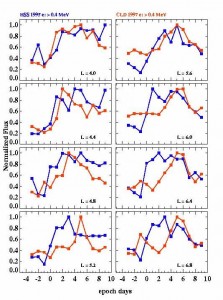SAMPEX measures Magnetospheric Response to High Speed Solar Wind Streams
It is well known that Relativistic electron flux enhancements are driven by High solar wind streams together with the southward turning of the IMF. Using SAMPEX data we have established important observational features of relativistic electron enhancements, namely, that they have a large L-shell extent and are nearly pitch-angle independent. That is, they exhibit global and coherent behaviour.
We have investigated the solar cycle dependence of these enhancements and report on preliminary findings in this science note. During the declining phase of the solar cycle high speed solar wind streams (HSS) produce recurrent geomagnetic storms often with relativistic electron enhancements where as during the ascending phase of solar cycle it is the coronal mass ejections (CME) which are the responsible agents as they often have high solar wind speed and southward IMF.
We have carried out a superposed epoch analysis of about 10 events each from the years 1995 and 1997, shown in Figure 1, representing the two solar cycle phases. The zero epoch is the time at which the solar wind velocity reaches its peak value. This analysis suggests that for the high energy electrons of energy 2-6 MeV, the flux profiles for both HSS and CME (Magetic Cloud) driven events are very similar with the peak flux of electrons occurring 5 to 6 days following the peak velocity of the solar wind. For electrons of intermediate energy electrons (about 0.5 MeV) the flux profiles are broader with a somewhat “double peaked” structure. HSS driven events seem to peak earlier than those driven by CMEs. These events class show more scatter in peak times across L shells. The Low energy electrons (about 0.03 MeV) again have similar flux profiles again for both HSS and CME events. The maximum flux of electrons occurs almost immediately following the maximum of solar wind velocity.
The superposed epoch profiles of interplanetary parameters are not “much” different over the ascending and descending parts of the solar cycle. Although the statistics are small, these results seem to suggest a variation with the solar cycle in the solar wind magnetosphere coupling for electrons of intermediate energy. We intend to extend this analysis by examining more electron enhancement events.
Contributed by Shri Kanekal, University of Colorado
«Return to the Results page
